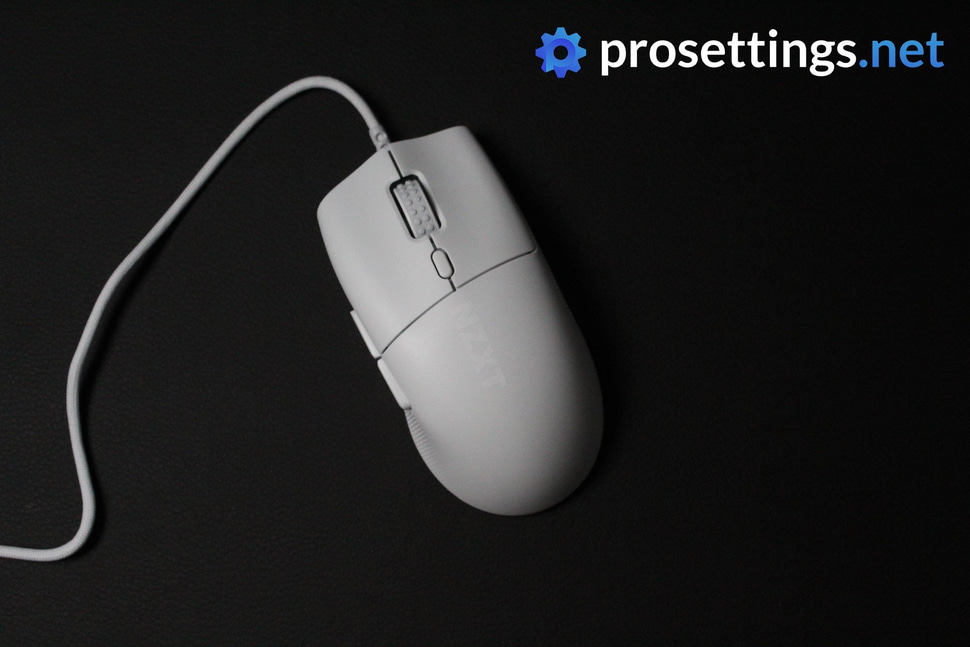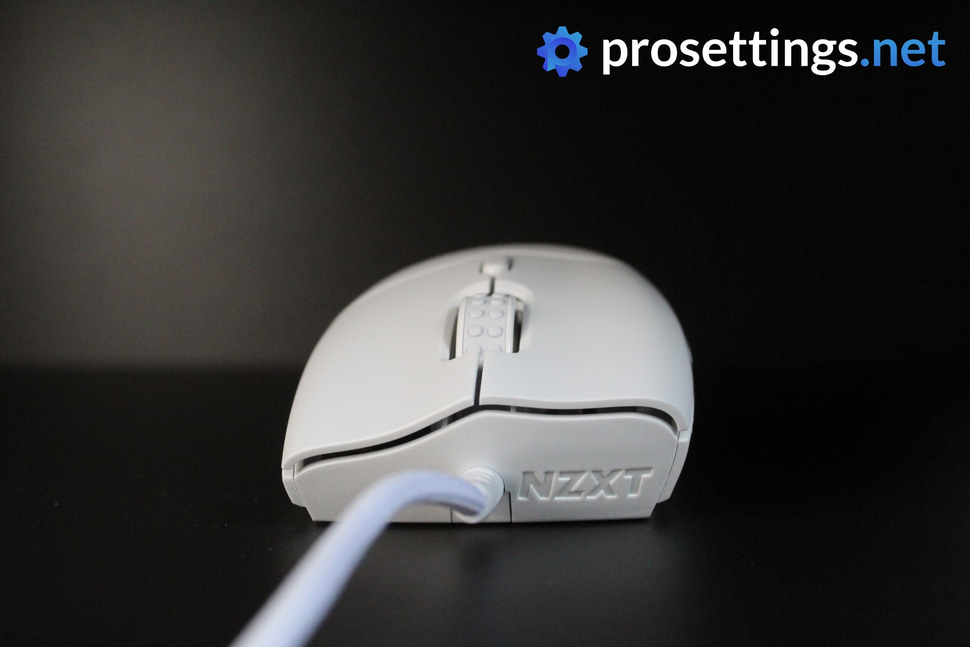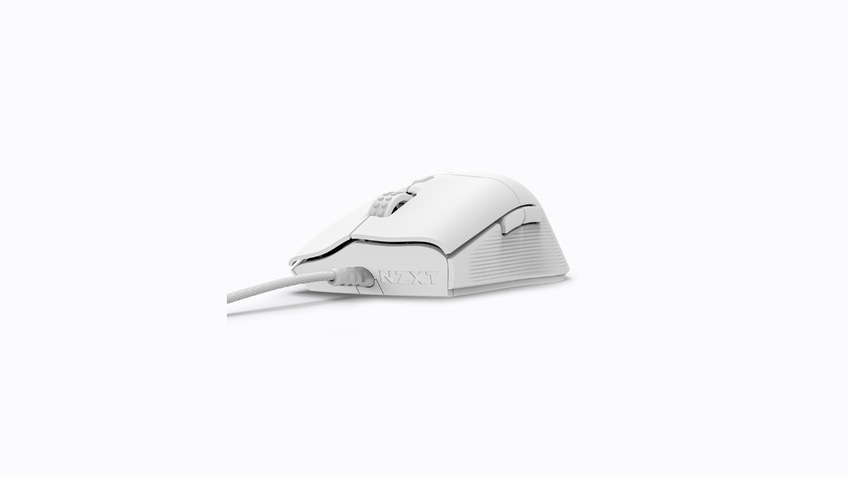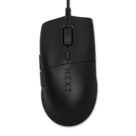Introduction
NZXT is a brand that’s mostly known for their PCs and PC components. But recently, they’ve been making a renewed push into the world of gaming peripherals. And if we’re looking at specs they’ve done their homework. A gaming mouse with optical switches, a max polling rate of 8000Hz, and a 3395 sensor usually costs well over $100, but the Lift 2 line offers those exact specs at budget prices. Read our full NZXT Lift 2 Ergo review to find out whether or not NZXT’s effort is worth the money.
At A Glance
NZXT Lift 2 Ergo
If it’s value you’re looking for, the NZXT Lift 2 Ergo is difficult to beat. It’s got all of today’s bells and whistles (such as a 3395 sensor and optical switches) packed inside a well-built 61 gram package.
Pros
- Pro-level specs for a budget price
- Good build quality
- Nicely implemented (optical) switches
Cons
- Large shape might not suit everyone
- Exterior parts of the shell can grind on softer mousepads or when applying a lot of pressure on the mouse
Specs
| Sensor | PMW 3395 |
|---|---|
| Polling Rate | 125 / 250 / 500 / 1000 / 2000 / 4000 / 8000 Hz |
| Button Switches | Optical Switches |
| Connection | Wired |
| Shape | Ergonomic |
| Length | 12.84cm |
| Height | 4.14cm |
| Weight | 61g |
| Width | 6.51cm |
First Impressions
Packaging
Inside the box of the NZXT Lift 2 Ergo you’ll find the mouse itself, and that’s it. Considering the price of the mouse, I wasn’t expecting a massively impressive unboxing experience but it would’ve been nice to see a pair of extra mouse feet, especially since the feet of the Lift 2 Ergo are quite oddly shaped and can be difficult to replace due to this.
The mouse itself
Being priced at $49.99 and still packing the latest and greatest tech, I expected to immediately spot obvious areas where corners had been cut, but that’s not the case. The Lift 2 Ergo feels like a quality product, and with its weight of ~60 grams it’s perfectly within today’s acceptable margins on the scale.
The only thing that might betray that this mouse is aimed towards the more budget-oriented end of the market is the fact that it comes with a cable. With that said: recent-ish fan favorites such as the Razer Viper 8KHz and the Endgame Gear OP1 8K also come with a cord, so it’s evident that there’s still a market for it. In addition to this, wired mice are also more durable (since there’s no battery that can degrade), more affordable, and don’t require charging, so there are definitely upsides to going with a cord as well.
Note: there are 2 options in the Lift 2 line. The Ergo (ergonomic) and the Symm (symmetrical). This review is about the Ergo, but both mice have the exact same internals.

Shape, Coating, and Mouse Feet
Shape
It’s quite common for brands that are taking their first couple of steps in the world of gaming mice to copy an existing popular shape and hope to snag a couple of customers that way, but NZXT hasn’t done that. The Lift 2 Ergo is, as far as I can tell, a unique shape.
If I had to compare it to an ‘existing’ mouse, it’d be to the Deathadder before its shape was reimagined (with the release of the V3 Pro) but it’s not an exact copy of that either. This is a large ergonomic mouse with a neutral design. There aren’t a lot of curves to be found, nor is there a drastic hump. This makes this a safe ergonomic shape that can accommodate a lot of specific grips, as long as your hands aren’t too small.
For me (18×10.5cm hands) this shape feels pretty good, but I like my (ergo) mice to be on the smaller side these days so it’s not something I would personally use as my main. With that said: I do feel like this is an interesting addition to the world of gaming mice, and I always love it when mouse companies don’t simply copy an existing shape.

Coating
In order to add extra grip, NZXT have added small dots to the side of the shell. This does actually help with increasing the overall grip for me, and I like the addition of these dots. Other parts of the shell have a rather smooth coating that, to me, feels good under almost all circumstances. The sections without dots can be a bit slippery if you have very dry hands, but for my grip style the dots were placed perfectly to allow for a consistent and reliable grip at all times.
My white unit is showing no signs of discoloration after my testing period, and the whole mouse also handles sweat and fingerprints well. The first couple of extremely hot summer days have sadly started rolling in where I live, and even in these sweaty and humid circumstances the mouse felt fine.
Obviously, I can’t tell if the mouse will keep looking and feeling pristine even after years of usage, but as far as I can evaluate the coating performs well.
Mouse Feet
The skates are -besides oddly shaped- too thin. Or maybe they’re recessed too deep on the bottom plate, I can’t say for sure.
Something that I almost immediately noticed during my testing is that -on softer mousepads- there’s a lot of scratchiness when using the Lift 2 Ergo. Initially, I thought this was down to the skates being too rough on the edges, but then I also tested the mouse on glass pads and didn’t really notice this feeling.
The culprit, as it turns out, is the frame of the mouse. The edges of the shell protrude too much compared to the mouse feet and they’re also quite thin/sharp, meaning that they tend to dig into softer surfaces. This becomes especially apparent if you’re someone who puts a lot of pressure on their mouse like myself. For me personally, this was a big issue since I main soft pads, but I also tested the mouse on some firmer (cloth) pads and it was less apparent there. As such, you’re probably fine if you don’t press down hard on your mouse and/or you use a firmer pad, but it’s good to be aware of this issue regardless.
The feet themselves are, as far as I can tell, okay. They required a bit of break-in time before they really got as smooth as I wanted them to be, but other than that I had no issues with them.

Recommended Grip Types
Given the size of the NZXT Lift 2 Ergo, I definitely wouldn’t recommend it to fingertip grippers. However, thanks to the rather safe shape this can be used by both claw- and palm grippers. Again, though, I should stress that you need at least average-sized hands if you want to use this mouse comfortably. I wouldn’t recommend it to people with smaller hands.
Buttons and Scroll Wheel
Buttons
The main buttons use optical switches underneath them, and those can be hit or miss when it comes to the click feeling. NZXT have pulled this off surprisingly well, though. Both main buttons activate with a good and decently crispy click that feels consistent no matter where you’re pressing the button.
Even more important than the actual switch feeling (to me anyway) is the implementation of the buttons, and NZXT have done a stellar job at this. Pre- and post travel distances fall well within acceptable margins and there’s no switch grinding or side travel on either button.
If I had to be really nitpicky I would say that the right button has a bit too much post travel, but in reality that’s not something that bothers me while playing games.
All in all, the implementation of the main buttons is done really well here.

Scroll Wheel
Despite functioning perfectly well, I feel like the wheel of the NZXT Lift 2 Ergo could use a bit more tactility. The individual scroll steps are rather difficult to distinguish, which can lead to erroneous scrolls from time to time. If you only use the wheel for ‘spamming’ actions (such as jumping) this is not really a problem, but if you use your mouse wheel to perform more precise actions such as swapping weapons then this could cause issues.
Aside from this, I have no remarks on the scroll wheel. It’s very grippy due to the textured rubberized coating, and it’s easy enough to click.
Side Buttons
There’s some pre- and post travel on both side buttons, which causes them to feel somewhat spongy. Not to an extent that it gets annoying during gameplay or anything, but I do feel like the travel could be reduced. With that said: the buttons themselves don’t travel inside the shell (which is a major pet peeve of mine) and actuate with a decently pleasing click, so I’d say that these are fine. Not great, but not terrible either.

Build Quality and Weight
NZXT really impressed me with the build quality of this mouse. Sure, 61 grams isn’t groundbreakingly light anymore, but there are plenty of brands who falter in the build quality department when trying to reduce the weight of their mice. My copy is built really solidly; there’s no creaking or flexing when applying pressure to the mouse, and there’s no rattling when tapping and shaking it.
Cable
It’s been a long time since I had to review a mouse with a cable attached to it so I’ve been out of the ‘cable game’ for quite some time but for me, this cable is fine. I felt no need to dust off my old bungee while testing the Lift 2 Ergo and the cable itself is flexible and smooth enough to not get caught on anything. It also comes out at a slight upward angle so that the cable doesn’t snag immediately after exiting the mouse.
I honestly thought I’d have a harder time getting back to a mouse with a cable, but I never felt annoyed or too bothered by the presence of said cable. I still prefer my mice to be wireless, but I wouldn’t have any issues using this cable for a LAN event or something like that.

Sensor and Performance
Sensor
Inside the NZXT Lift 2 Ergo is the 3395 sensor. That’s one of the newest sensors around, and it’s implemented as it should here. It’s capable of polling rates of up to 8000Hz and as far as I can tell it works fine at those polling rates. I should say that the polling rate seems to drop down to ~4000Hz if I slow down my mouse movements, but since it never drops below that 4KHz level and I also noticed no ingame issues during my testing I’m inclined to say that this isn’t a big problem.
Latency, DPI deviation, and other metrics are all within acceptable margins, so NZXT have done a fine job at implementing this sensor.
Ingame Performance
Given the fact that the NZXT Lift 2 Ergo has all of today’s latest and greatest tech on the inside, it’s going to perform absolutely perfectly for gaming. The only ‘drawback’ is the fact that it comes with a wire, but whether or not that’s a deal breaker comes down to personal preferences.
I personally don’t want to go back to wired mice unless the shape is absolutely perfect for me, but I do have to say that I love seeing mice like these get released. This is a great option for people who want top-of-the-line performances and specs without paying well over $100 for the privilege. It’s also cool to see a big brand making a budget-oriented mouse that doesn’t make any compromises when it comes to specs. If you don’t mind using a cable then this is up there with the best of the best when it comes to ingame performances.

Mouse Configuration and Options
Inside NZXT’s CAM software, you can adjust the polling rate, LOD, and DPI. You can also rebind the buttons on the mouse as well as create macros. You can save your settings to up to 5 different onboard profiles that you can switch between by using the button on the top of the shell. This type of ‘DPI button’ is a bit of a rarity to see on performance-focused mice these days, but it’s placed thoughtfully and never got in the way for me.
In short: you can configure pretty much anything you’d want to configure on the NZXT Lift 2 Ergo.
Alternatives
The NZXT Lift 2 Ergo has a unique shape so there aren’t many direct competitors out there, especially if you also start taking budget into account. However, I’ll compare it to some of the ‘usual suspects’ in the large ergo mouse scene in order to give readers a complete picture.
NZXT Lift 2 Ergo vs Razer DeathAdder V2
The NZXT Lift 2 Ergo’s shape immediately reminded me of the Razer DeathAdder V2. Prior to the shape redesign, DeathAdders were large, flat-feeling mice that initially somewhat match the feeling that the Lift 2 Ergo gives, even though they’re not nearly the same when you actually start using them.
The NZXT Lift 2 Ergo is a lot more affordable than the Razer DeathAdder V2 and has better specs, so if we’re purely looking at price/performance, the Lift 2 Ergo is the better choice.
See our Razer DeathAdder V2 Review
NZXT Lift 2 Ergo vs ZOWIE EC1
The ZOWIE EC1 is the largest mouse in ZOWIE’s ergo mouse lineup, but it has a very different in-hand feeling than the Lift 2 Ergo if you ask me. The ZOWIE is a lot curvier, whereas the Lift 2 Ergo is flatter feeling. When it comes to specs, the Lift 2 Ergo beats all (current) iterations of the ZOWIE EC1.

Conclusion
If it’s value you’re looking for, the NZXT Lift 2 Ergo is difficult to beat. It’s got all of today’s bells and whistles (such as a 3395 sensor and optical switches) packed inside a well-built 61 gram package. The MSRP is $49.99, which is a fantastic price for these kinds of performances if you ask me. The only real compromise you have to make if you decide to go for the Lift 2 Ergo lies in the fact that you’ll have to play with a cable. If you can deal with that (and its rather big size) it’s a fantastic option.
As is the case with pretty much every product, it’s not all perfect. There are some minor flaws here and there that could be improved in future iterations. And -depending on your playing style and mousepad- the shell grinding can definitely be seen as a big flaw. But as a package, this is a very impressive release, and I’m eagerly awaiting to see what NZXT is going to do next with their mice.
Should they decide to go for the premium (wireless) route, I do hope that they keep offering wired versions as well. Not every gamer can afford to or wants to spend 150 dollars on a mouse, and products like this are a fantastic option for budget-conscious gamers.
This product was received for free from the manufacturer and given to our reviewer to test and review. Brands and manufacturers have no editorial control over our reviews. For more information, check out our review FAQ.







